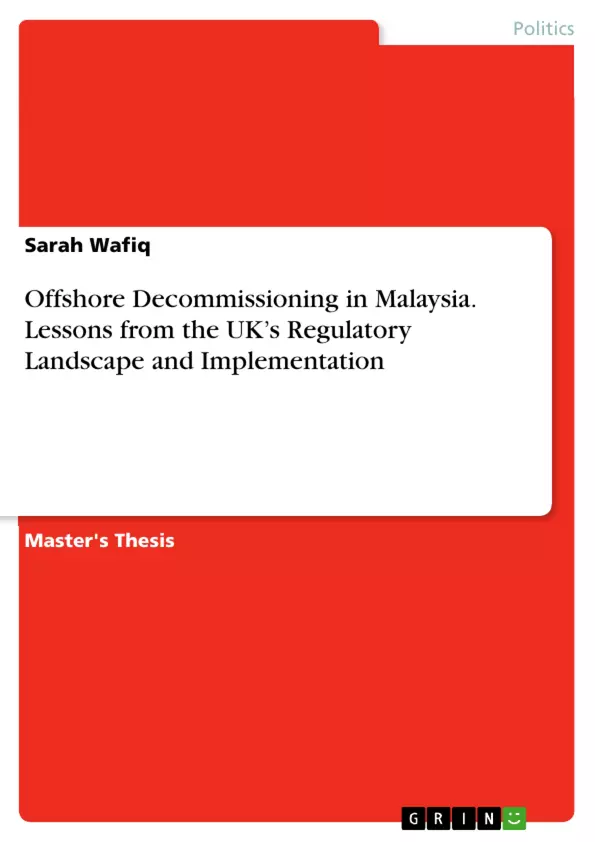This research aimed at determining whether the Malaysian regulatory landscape governing the offshore decommissioning of petroleum facilities is adequate to face the scale of offshore decommissioning activities that will involve Malaysia, or whether it may need to be reviewed and inspired by the more established and long-standing UK’s offshore decommissioning regime and practices. The researcher estimated that 195 offshore installations will undergo decommissioning in Malaysia by the year 2025, with a growth of offshore decommissioning activities equal to 244.4% over a ten-year period. Nevertheless, Malaysia has not yet promulgated any national decommissioning regulations for the oil and gas (O&G) industry – it only relies on the guidelines provided by its national oil company (NOC) PETRONAS.
However, both these guidelines and the current Malaysian oil production-sharing contract (PSC) appear to be lacking guiding principles, and seem to be allowing international oil companies (IOCs) to escape their legal and financial responsibilities associated with offshore decommissioning. In light of these information, therefore, a comparison was carried out between the British and Malaysian offshore decommissioning scenarios, and possible improvement actions to the Malaysian legal and practical framework, inspired by the British one, were proposed by the researcher.
Inhaltsverzeichnis (Table of Contents)
- ABSTRACT
- TABLE OF CONTENTS
- LIST OF FIGURES
- LIST OF TABLES
- ACKNOWLEDGEMENTS
- TECHNICAL TERMINOLOGY
- 1.0 INTRODUCTION
- 1.1 RESEARCH BACKGROUND
- 1.2 OVERVIEW OF OFFSHORE DECOMMISSIONING IN MALAYSIA AND IN THE UK
- 1.3 RESEARCH AIM, OBJECTIVES AND QUESTIONS
- 1.3.1 Research aim
- 1.3.2 Research objectives
- 1.3.3 Research questions
- 1.4 RESEARCH STRUCTURE
- 2.0 LITERATURE REVIEW
- 2.1 UNDERSTANDING DECOMMISSIONING
- 2.2 BRIEF HISTORY OF WORLDWIDE OFFSHORE DECOMMISSIONING WITH A LOOK AT FUTURE PROSPECTS
- 2.3 OFFSHORE DECOMMISSIONING OPTIONS
- 2.4 OFFSHORE DECOMMISSIONING INTERNATIONAL LEGAL REQUIREMENTS
- 2.5 THE UK'S EXPERIENCE
- 2.5.1 Overview of the UK's offshore decommissioning legislation
- 2.5.2 Overview of the UK's offshore installations and decommissioning practices with a look at future prospects
- 2.6 MALAYSIA'S EXPERIENCE
- 2.6.1 Overview of Malaysia's offshore decommissioning legislation
- 2.6.2 Overview of Malaysia's offshore installations and decommissioning practices with a look at future prospects
- 2.7 KEY FINDINGS
- 2.7.1 What has been researched?
- 2.7.2 What are the research gaps?
- 3.0 METHODOLOGY
- 3.1 INTRODUCTION
- 3.2 RESEARCH DESIGN AND METHODOLOGY
- 3.3 DATA COLLECTION METHOD
- 3.4 ANALYTICAL PROCEDURE
- 3.4.1 How to estimate the scale of offshore decommissioning activities in Malaysia over next decade?
- 3.4.2 How to determine the practical impact of Malaysia's offshore decommissioning legislation's weaknesses?
- 3.4.3 How to suggest lessons on offshore decommissioning regulation and implementation that Malaysia could learn from the UK's experience?
- 3.5 RESEARCH LIMITATIONS
- 3.5.1 Limitations in achieving objective I
- 3.5.2 Limitations in achieving objective II
- 3.5.3 Limitations in achieving objective III
- 4.0 RESULTS AND DISCUSSION
- 4.1 INTRODUCTION
- 4.2 RESULTS ANALYSIS
- 4.2.1 Estimated offshore decommissioning activities in Malaysia over next decade
- 4.2.2 Weak in theory and practice
- 4.2.3 Comparison study of the British and Malaysian offshore decommissioning regulation and implementation
- 4.3 KEY FINDINGS
- 5.0 CONCLUSION AND RECOMMENDATIONS
- 5.1 CONCLUSION
- 5.2 RECOMMENDATIONS
- REFERENCE LIST
Zielsetzung und Themenschwerpunkte (Objectives and Key Themes)
This research aimed to evaluate whether the Malaysian regulatory framework governing offshore decommissioning is sufficient to manage the scale of impending activities, or if it requires review and inspiration from the more established UK regime. Specifically, the study projected 195 offshore installations slated for decommissioning in Malaysia by 2025, highlighting a substantial increase in activities. The research explores the shortcomings of the existing regulatory landscape and its potential consequences.
- The adequacy of the Malaysian offshore decommissioning regulatory landscape.
- The potential impact of offshore decommissioning activities on Malaysia’s marine environment and industry.
- Comparative analysis of the UK and Malaysian offshore decommissioning practices and regulations.
- The identification of key lessons learned from the UK’s experience in offshore decommissioning that can be applied to Malaysia.
- Recommendations for improving Malaysia's offshore decommissioning regulatory framework and practices.
Zusammenfassung der Kapitel (Chapter Summaries)
- Chapter 1: Introduces the research background, providing an overview of offshore decommissioning in Malaysia and the UK. It outlines the research aim, objectives, and questions guiding the study. The chapter also presents the research structure.
- Chapter 2: Reviews relevant literature on decommissioning, outlining various decommissioning options and international legal requirements. It provides detailed insights into the UK’s experience with offshore decommissioning legislation, practices, and future prospects. Additionally, the chapter examines the Malaysian experience, including its offshore decommissioning legislation, practices, and future prospects. The chapter concludes with a summary of key findings and research gaps.
- Chapter 3: Explains the research design and methodology employed, including data collection methods and analytical procedures. It clarifies the process of estimating the scale of offshore decommissioning activities in Malaysia, determining the impact of legislative weaknesses, and deriving lessons from the UK’s experience. The chapter also acknowledges potential research limitations.
- Chapter 4: Presents the research results and discussion, including estimates of offshore decommissioning activities in Malaysia over the next decade. It analyzes the shortcomings of Malaysia’s offshore decommissioning legislation and implementation, and compares the British and Malaysian approaches. The chapter concludes with a summary of key findings.
Schlüsselwörter (Keywords)
Offshore decommissioning, Malaysia, UK, regulatory landscape, environmental impact, industry practices, international obligations, decommissioning options, decommissioning legislation, oil and gas industry, marine environment, health and safety.
- Quote paper
- Sarah Wafiq (Author), 2015, Offshore Decommissioning in Malaysia. Lessons from the UK’s Regulatory Landscape and Implementation, Munich, GRIN Verlag, https://www.grin.com/document/338540



